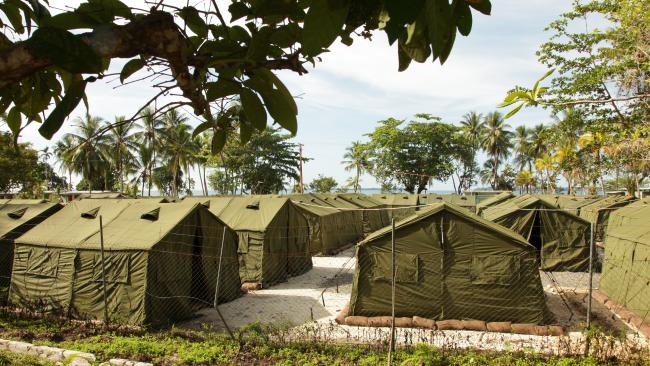- Home
- All the way with Adam
- Analysing Trump-Turnbull Phone X-change
- Are we there yet ?
- Australia's diminishing political capital
- Boat turnback bribery and predictable silence
- Causes for Refugee Movements: Political Interference
- Corrupt Syndicate and Cover-ups
- Crimes of Secretary of DIBP (2011-2014)
- Details on Fazel Chgeni case:
- Election Season and Boat Secrecies
- Elephants and Lies -- Xmas season 2017
- End Offshore Slavery
- Evacuate the Asylum-seekers from Offshore Detention Centres
- Future for PNG Asylum-seekers
- Growing List of Hero Doctors
- Honesty is the best policy on payments to smugglers
- Lady Justice shines on the Pacific
- Lectures and Pressures
- Lets shine our solidarity on Manus Island and Nauru
- Lies, Spins, Cockroach and Rodents
- Ltr to Andrew Wilkie and Adam Brandt MP
- Media monopoly and conspiracy of silence
- Media monopoly: blackout vs spotlight
- Nauruan MOU and Dabwido -- Devil not in Him
- No Lecture, More Pressure
- OSB and Public Interest Immunity
- OSB, Turnbacks and Political cover-ups
- On wherever of the Internet
- Pacific Solution for Justice
- Refugees, Trust and Faith
- Royal Commission on Offshore Processing Regime, an initiative worth supporting
- Serving the Horizontal Outreach
- Shedding some light on OSB
- Should Dutton be sacked for adopting Cockroach Agenda
- Standing up for Refugees ? Set up a FB Group and Becomes Human Rights Information Retailer:
- The 2018 Unpacking of Xmas Lies
- The Syndicate of Corruption
- The myths, secrecies and refugee policy
- The scandal at hand
- Trade Your Vote for Refugees
- Treasonous minions
- UN Refugee Convention and Huston Report 2012 , a case of public mood-swings and government policy shift
- Virtual Communities - All about Respect
- Who gonna park on that spot ?
- Witchcraft behind the Spin
- Put yourself in Indonesian's shoes
- Australian Government's bribery payments to people smugglers
- Boat bribery payments and motives behind
- Labor, Liberal and Mandatory Detention Policy
- The Irony of Australian Government's "Tough on Crimes"
- Tilting at Canberra Windmills
- Why my polly is so silent
- The ALP Position on asylum-seekers detained offshore
- The Cowards of Australia
- Refugee Policy Moonwalks and ALP
- A Lie is a 'Lie' and a Crime is a 'Crime'
- Attributions
- AFP and ICC
- (2022-Sep) OTP-ICC Preliminary finding and Request for ICC jurisdiction
- (2018-Apr) Additional Submission to ICC re: Enslavement
- (2017-Jun) Enslavement in Manus Island and Nauru
- Dob-in to International Criminal Court
- Request ICRC to Evacuate Asylum-seekers
- Rome Statute Article 25 on Individual Responsiblity
- STATE OF TORTURE LAW IN AUSTRALIA
- Urgency on Offshore Situation
- Bomana
- Asylum Processing Under PNG/Naurual Laws: Lawful or Unlawful?
- Freedom Yours, Justice Ours
- LEGAL REMEDY FOR DETAINEES IN KP, MANTRA & ITAs
- ERRONEOUS OFFSHORE LAWS
- LIBERTY - BROADENING THE SCOPE
- EXECUTIVE EMERGENCY POWER, COMMON LAW AND ALIENS
- Bomana53# and Convention Obligation
- Legal Boundary of Offshore Processing Regime
- HCA Failed Offshore Detention Challenge S195/2016
- UNORG
- (Feb 2022) Submission to Human Rights Council and Special Rapporteur on Slavery
- (Sep-2019) Letter to UN Secretary-General Guterres
- (Sep-2018) Letter to President of Nauru and Prime Minister of New Zealand
- (Aug-2019) Resettlement Appeal to European Council
- (Jul-2019) Letter to Canadian PM Justin Trudeau
- (Dec-2017) Letter to President of ICRC
- Slavery
- Deaths in Detention
- Archived: 1992-2004
Lectures and Pressures -- Human Rights and Common Laws
DIBP/IHMS Contracts
Some Details
[Broadcast: 27 Nov 2022 ]
COMMONWEALTH/IHMS HEALTHCARE CONTRACTS--SOME DETAILS: The International Health and Medical Services (IHMS) is a subsidiary of global health and security company International SOS. The provision of health care to asylum seekers on Nauru and Manus Island was initially governed by a "Heads of Agreement" between DIBP and IHMS. The IHMS has been providing detention health services at facilities within Australia since 2003 [#9].
In earlier years (2005) [#8], the IHMS was sub-contracted by Global Solutions Ltd (GSL) to provide general medical services, but also known to have supplied the psychiatrist doctor. The GSL sub-contracted another entity for the detainee's mental health care services at that time. In January 2009, the Commonwealth Government (DIBP) had entered direct contract with IHMS, under the "Health Service Contract" [#11].
THE TOTAL VALUE OF IHMS CONTRACT IN 2015
Although IHMS seemed to have started in 2003 as a small player, its contractual value had increased to AUD1.6 billion by 2015, according to the Guardian report [#10]:
"The company holds two main contracts for asylum seeker healthcare in Australia: it received $951m for health services from 2009 to 2014 at onshore detention centres, and a further $231m for health services on Nauru and Manus Island. It was recently commissioned to provide another five years of services until December 2019 for onshore detention centres in a further $438m contract."
We can be certain by looking at such value of contract the IHMS has incentives to maintain good relationship with Commonwealth, especially in protecting the government's detention policies.
KPMG REVIEW IN RISK ASSESSMENT
In the light of the Guardian allegations in July 2015, the Department has hired KPMG to review the risk assessment [#11]:
"On 22 July 2015, DHS Branch established a team (the Review Team) to complete the Review. ...... The Review Team firstly developed a Risk Assessment, in relation to the allegations, to identify risks around detainee service delivery, contract performance and stakeholder relations. The Risk Assessment also informed the production of a Work Plan for DHS Branch, which includes actions to address recommendations from this review."
The Risk Assessment, of course, was to identify any legal liabilities for both IHMS and the government. There were never a mention of the "risks to detainees" throughout the process. At this point, I certainly felt indignant that these people (the Government and Businesses) are well provisioned to "look after themselves" -- with all our tax payers monies -- but none taken into consideration of detainees.
IMPLICATIONS ON DETAIL EXAMINATION OF 2005 S v SECRETARY JUDGMENT [#8]
The judgment entered in 2005 on the case of two detainees, named S and M, was in relation to whether these psychiatric patients can be transferred to a higher level care, invoking South Australian Mental Health Act. The judgment was about civil tort case in requesting the administrative review in nature. The parties to that proceeding -- i.e. the plaintiffs S and M and their legal Counsel, together with Organisations involved -- are still active, I believe. On my reading of the judgment, there are some indication of criminal liabilities arising from violations of common law by the service providers. The civil tort case was considered closed by the Judge since 2005. However, the criminal case may still be open (I am not sure though).
In any case, my intention here has been to extract out information on the DIBP/IHMS healthcare contract and examining implementation of that contract. I am not a lawyer and belonging to none of the parties to that proceeding, as publicly open discussion of that historic case, I shall be exhausting anything I find without prejudice. That'll be in the next few discussions. -- Cheers, NetIPR.
Commonwealth and
IHMS Contracts
[Broadcast: 22 Nov 2022 ]
COMMONWEALTH AND IHMS CONTRACTS: Friends, in our discussion on "Medevac and Common Law Patient Rights", there is the requirement about the doctor-patient contractual duty on asylum-seeker patient to be break down in accordance with DIBP/IHMS contracted out structure. This will enable us to identify the legal duty that owed on an offshore asylum-seeker patient by each entities. Here, I use the generic word "provider" to represent each layers of health care service provider. Hence:
=> the provider-DIBP has overall non-delegable duty on health care of offshore asylum-seekers;
=> the provider-contractor-Broadspectrum has contractual duty in care, including health care, of asylum-seekers that has been stipulated by written terms of contract with DIBP;
=> the provider-contractor-IHMS has contractual duty on health care of offshore asylum-seekers that has been stipulated by written terms of contract with DIBP;
=> the provider-subcontractor-doctor has written employment contract with IHMS. That provider-doctor also has the doctor-patient implied-unwritten contract when treating the asylum-seeker patient. The subcontracted provider-doctor can either be a physician or a psychiatrist.
OBSTACLES IDENTIFYING DETAIL TERMS OF CONTRACTS
In this task, we are encountering an inevitable difficulty; How can one find out about the detail terms of contract when you don't have any copy of those documents? Of course, I am just like you, a grassroots campaigner who having no capacity to 'compel' the Department of Home Affairs or IHMS to release those commercial-in-confidence contracts to the public. We, the public, however do get to know or be heard about the contents of these contracts anyway. In legal-terms, we have at least "hearsay evidence" [#5] for, lets say, some of the contents of the contract. None the less, more information on these terms of contract, in some part, can be extracted further from reliable sources such as court judgment, ombudsman and senate reports. This is the only method available at this stage and information obtained cannot be complete, of course.
COMMONWEALTH'S MOTIVE, POLICY, CONTRACT AND CONDUCT
The detail terms of contract, to my view, are not necessarily of the material importance in the offshore medevac cases. In common law, the DIBP/IHMS conduct and the result of conduct on individual asylum-seekers are of material importance. The evidence produced by Faysal and his Manus Island asylum-seeker friends, in this respect, is of great importance to us: material in its nature and cannot be disputed of its authenticity [#6]. (To my way of thinking, almost half of the Crime House could have been taken down if proper action is taken.) What we need, I suppose, is these incidents to link-up the chain-of-command within DIBP/IHMS hierarchy.
The majority of asylum-seekers who had been refused medevac are suffering from psychiatric condition as a result of major depression. There is empirical evidence for systemic denial of care to asylum-seekers with psychiatric illnesses [#7]. Cases of Hamid Shamshiripour and Fariborz Karami are prime examples of such denial of care. Historically, the Commonwealth, in conjunction with IHMS, had track record for denying medical care to asylum-seekers with psychiatric patients since 2005 [#8]. We will need, perhaps, to have a closer look into that case, "S v Secretary, DIMIA (2005)" [#8], so as to be able to gauge how the Commonwealth Departments and IHMS have evolved in policy and practical conduct with regards to managing the asylum-seekers with psychiatric illness.-- Cheers, NetIPR.
Civil Torts and
Criminal Prosecutions [Broadcast: 7 Nov 2022 ]
CIVIL TORTS VS CRIMINAL PROSECUTION: Friends, Australia's asylum policy, offshore detention practice and emerging civil and criminal liabilities are very complex. In this very complex legal-political environment, moving forwards on refugee rights can be daunting tasks. But we, as the human right movement in Australia, have been fortunate to get a "report card" of sort from an independent analyst by the name of Gabrielle Holly. All the while, we -- the general public in Australia -- been too busy with refugee medevac, the bush fires & Covid-19 pandemic, Ms Holly was able to compile comprehensive and unbiased assessment of the situation in her 2020 publication, "Challenges to Australia’s Offshore Detention Regime and the Limits of Strategic Tort Litigation". I enclosed a direct link to the original URL [#1]. I would invite everyone to view the article, where many issues that are still being at our hand. Such independent assessment will give us new perspectives of current struggle.
DIFFERENCE OF CIVIL TORTS AND CRIMINAL PROSECUTION
Although would be for some -- to me at first -- that seemed indistinguishable between the legal actions against governments on civil torts (&class actions) and criminal prosecutions, the objectives and procedure are being quite different.
For civil torts actions, including class actions, the principal objective is to recover or remedy the damage or injury done to the plaintiff (asylum-seeker in our cases). The objectives and procedure for such civil tort legal actions were succinctly summarised in Criminal Law by Univ. of Minnesota [#3]:
"In civil litigation, an injured party sues to receive a court-ordered remedy, such as money, property, or some sort of performance. Anyone who is injured—an individual, corporation, or other business entity—can sue civilly. In a civil litigation matter, the injured party that is suing is called the plaintiff. A plaintiff must hire and pay for an attorney or represent himself or herself."
In the civil tort cases of our offshore asylum-seekers, the children on Nauru in particular, were being represented mainly by the National Justice Project lawyers. These civil tort cases were aimed at the Commonwealth Government to "perform" the act of bringing sick children to appropriate destination, which is to Australia. These legal actions had, at some point, limited success in the Commonwealth Parliament enacting Medevac Law; which was later being repealed by Morrison LNP Government [#1]. Never the less, the permanent and lasting achievement by these civil tort legations, to my view, is in clarifying the important sections of the Migration Act (1958, Cth). For example, the Commonwealth (Government & Parliament) have enacted sections of above mention act, s. 198AHA, s. 494 and s. 474, which were being used by the government in limiting asylum-seekers bringing (any) legal against the Commonwealth. This clarification has now been achieved through the landmark court judgment of S99/2016[#4] and FCAFC148/2019[#2].
CLASS ACTIONS FOR MONETARY COMPENSATION
The class actions, which is a type of civil tort, was notably initiated by the Slater and Gordon Law firm. This particular action has had modest monetary outcomes for some asylum-seekers. However, caution being made as to taking such class action for monetary compensation, which may place limit on taking of further actions [#1]:
"These past settlements in proceedings concerning the offshore detention regime will have an effect on future claims. The most significant of these is the Kamasaee settlement that was approved by the Supreme Court of Victoria on September 6, 2017 and that binds all members of the class. The effect of the settlement is that no class member will be able to take any further step in the class action and will not be able to take any further action in relation to the claims made in the class action, or bring any future claims against the defendants, third party, or their related parties relating to the subject matter of the class action. Under Australia’s opt-out class action system, class members who do not opt out are bound by the terms of the settlement, even where they do not receive the benefit of financial compensation."
MONETARY COMPENSATION COULD NOT BE THE OBJECTIVE
To my assessment, the obvious desire by asylum-seekers have been to build-up their lives -- which require substantive residency status -- and as to make proper contributions towards Australia. To extract monetary compensation from Commonwealth government, which they understood were being our taxpayers monies, would never have been their main objectives. When no other else of remedial measures to bring up about their plights, the asylum-seekers have to initiate such compensatory tort actions. Too often, of course, we -- the activists -- have been accused of "asserting opinions" or "imposing values" upon others such as asylum-seekers. But on this assessment, we cannot be going wrong, I must say.
Anyway, the class actions, especially with monetary objective, have been less desirable in comparison to individual tort actions, we must keep open minded about any type of legal actions that do not limit the ability for further actions.
CRIMINAL PROSECUTIONS
In contrast to those civil tort actions, Australia's criminal justice system have provided another avenue for legal remedy. The criminal prosecution has sets apart from civil tort litigation in both objectives and procedure. The objective for a criminal prosecution is to "punish" the wrongdoer(s). In a criminal prosecution, the government, in the stead of the victim, has to institutes the criminal proceedings.
Unlike civil tort actions, the victim is not required to hire his/her own lawyer. If the defendant committing a crime, the Australian government in the name of Crown pursues the criminal prosecution. As in a civil lawsuit, the alleged wrongdoer is called the defendant and can be an individual, corporation, or in our case, the governmental entity. The attorney who represents the government controls the criminal prosecution (See "Characteristics of Criminal Prosecution" in [#3]).
PARALLELS IN CIVIL TORTS AND CRIMINAL PROSECUTIONS
In both types of legal actions, there are notable similarities:
=> establishment of the duty of care;
=> identifying breach of that duty;
=> causation of the damage or injury.
For criminal prosecutions, it required the damage or injury must be "exemplary", i.e. severe and outstanding. The death of person(s) obviously warrants such criminal prosecution. But any other outstanding injury and severe damages to a person may also qualify to request for the criminal prosecutions.
One obviously numbing question to ask is how a government can prosecute itself ??, i.e. its own members and entities. This, perhaps, has been the major challenge for pursuing the task of the "Crime Against Humanity", which the government itself being seen as part of the perpetrators of the crime.
PARTICIPATING ACTION FOR JUSTICE
Current actions on criminal justice, that of offshore actions on ICC and Faysal Ahmed a likes, are well worth participating by all. Especially those asylum-seekers from Manus and Nauru -- who they themselves have suffered wrongs -- are especially encouraged to participate in such actions. This is because justice belongs to all and, as such, must have to be serve by all.
-- Cheers, NetIPR.
Lectures and Pressures
Human Rights and Common Laws [Broadcast: 27 Oct 2022 ]
Friends, there are most important and satisfying aspects to the 2019 Federal Appeal Court decision delivered by justices KENNY, ROBERTSON AND GRIFFITHS JJ [#2]. Having read content of the judgment, I was a little surprise about the lack of proper media report or academic commentary on its importance. That combined judgment was made in August 2019 in relation to the four offshore medical evacuation cases from Nauru. These cases were being raised at various times in 2018 by the National Justice Project and Maurice Blackburn Lawyers, of which some involving severely ill children on Nauru. On applicants requesting medical evacuations in 2018, the Federal Court had granted "interlocutory injunctive reliefs"; meaning the emergency evacuation order as intervention were made by the Court to preserve lives whilst the laws or jurisdictions were still in dispute with the Commonwealth government. The government, in these cases, had been kept insisting that (i) the Commonwealth has no responsibility [to intervene the applicants' illnesses] on those offshore detainees (ii) the Federal Court would be in error on its intervention because the Parliament had passed law (s. 494 with 198AHA) prohibiting these offshore UMAs staging up court cases, except for the High Court.
ANOTHER LANDMARK JUDGMENT
I suppose, we -- the public refugee supporters -- were a little-bit lagged in time of appreciating that this has been an important judgment that is comparable to M68/2015 and S99/2016 when it comes to counterbalancing the Commonwealth Government's draconian offshore refugee laws and policies. The delayed noticing the significance of this court judgment were, perhaps, due to the silence in the media: Mass media would not report when the government's side loses a court case ! Any way, the judges have delivered their judgment with comprehensive historical accounts of s.494 and s.198AHA. Given such clarity and awesome authorities that have carried through, in my view, this judgment should be considered as one of the landmark judgment.
AGAINST TYRANNY OF MAJORITY
On offshore medevac cases, the government had routinely argued, citing various statutory law provisions of Migration Act (1958, Cth), these asylum-seekers have no legal rights (whatsoever) to be presented in Australian Courts; the statutory bar (s.494, s.198AHA) already applied so that such class of person(s)[the offshore asylum-seekers, UMAs] are not entitled to seek remedy through civil tort damage claims.
The judgment addressed the way the government have been provisioning and applying the statutory laws against UMAs, tantamount to restricting the liberty of UMAs in entirety. The judges had carefully pin pointed the operation of ss.494 (1)(ca). This sub-section was introduced by Labor in 2012; which found to be having no proper legal meanings!!
"494AB Bar on certain legal proceedings relating to transitory persons:
(1)(ca) proceedings relating to the performance or exercise of a function, duty or power under Subdivision B of Division 8 of Part 2 in relation to a transitory person;"
NO CONNECTION WITH 198AHA
The validity for s 198AHA was examined in M68/2015 and affirmed by the High Court. Rather disturbingly, the legally imprecise catch-all word-in-meanings of "performance of function" "taking of action" etc.. were repeated again when enacting 198AHA in 2015:
"s. 198AHA Power to take action etc. in relation to arrangement or regional processing functions of a country
(2) The Commonwealth may do all or any of the following:
(a) take, or cause to be taken, any action in relation to the arrangement or the regional processing functions of the country;
(b) make payments, or cause payments to be made, in relation to the arrangement or the regional processing functions of the country;
(c) do anything else that is incidental or conducive to the taking of such action or the making of such payments.
The judges had carefully walked through legislative history and of statutory constructions of 198AHA, dispelling the political myths surrounding it [#2]:
"199. Section 198AHA does not confer any statutory powers, duties or functions on the Commonwealth, but rather confers a bare capacity that enables the Commonwealth to be conferred with powers or functions or duties under the laws of a regional processing country."
Therefore, in essence, the s. 198AHA does not grant the government and its [contractor] agents any "statutory powers" to do anything overseas. It is only allowing executive government to "finance" or "facilitate" the operations on RPCs. As such, we -- the public -- can now be clear with regards to offshore operations that:
=> the Commonwealth employees and its contractor agents were NEVER under the protections of Australian (statutory) laws;
=> Any criminal undertakings by such employees and agents -- examples as that of bribery to foreign entities -- are of their own personal responsibility [ This is rather tricky because s. 198AHA grants the Executive the "capacity" to fund its offshore projects, to all intent and purposes, in a lawful manner ];
=> Individual attributions for the ordinary crime liabilities -- bribery, abuse, assault and murder -- are available under PNG/Nauruan laws; So too would go the common law respondeat superior liabilities towards ministers/head-of-state of PNG/Nauru;
=> the common laws civil tort (negligence) charges are available to the Commonwealth and its Agents ( IHMS, Broadspectrum, Wilson Security -- all Australian registered! ); there is now no statutory provisions hindering such legal proceedings.
What that have referred here are, of course, for the classes of "ordinary" criminal or civil damages. For the crimes against humanity enslavement and torture, there will be far more reaching out by the laws because of the nature of those crimes. Because of this FCAFC judgment [#2], no offshore crimes will ever have been left in the "legal no-man's land", so to speak.
For this clarity on laws re offshore situations, we owe it to the important works done by the National Justice Project and Maurice Blackburn Lawyers; their tenacious efforts and to their un-compromised stand that taken on the rights of their offshore medevac clients.
-- Cheers, NetIPR.
Dual Accessible Reference and Resources
[#1] Challenges to Australia’s Offshore Detention Regime and the Limits of Strategic Tort Litigation by Gabrielle Holly (PDF).
 https://doi.org/10.1017/glj.2020.26
https://doi.org/10.1017/glj.2020.26
[#2] The August 2019 Federal Court judgment FCAFC148/2019 (PDF).
 https://www.judgments.fedcourt.gov.au/judgments/Judgments/fca/full/2019/...
https://www.judgments.fedcourt.gov.au/judgments/Judgments/fca/full/2019/...
[#3] The Criminal Law in US by University of Minnesota (PDF).
 https://open.lib.umn.edu/criminallaw/
https://open.lib.umn.edu/criminallaw/
[#4] The Bromberg Judgment S99/2016 FCA483 (PDF).
 http://www.aus4iccwitness.org/legal-resources/20160506_bromberg-judgment...
http://www.aus4iccwitness.org/legal-resources/20160506_bromberg-judgment...
[#8] S v Secretary, Department of Immigration and Multicultural and Indigenous Affairs; 2005/FCA549 (PDF).

https://pinpoint.cch.com.au/document/legauUio390238sl10609811/s-v-secret...
[#9] Coroners Court of Queensland, Inquest into the death of Hamid KHAZAEI, 30 July 2018 (PDF).

http://www.aus4iccwitness.org/legal-resources/20180730_khazaei-coroners-...
[#11] Review of Allegation Made against IHMS in the Guardian Australia in July 2015; FOI release date, 12 Jun 2019 (PDF).

http://www.aus4iccwitness.org/docs/20190612_foi-160401146-respond-to-gua...
[#5] Hearsay rule
https://www.judcom.nsw.gov.au/publications/benchbks/civil/hearsay.html
[#6] Faysal Ahmed Evidence
http://www.aus4iccwitness.org/evidence/20161231_faysal-ahmed-evidence.pdf
[#7] Senator Kim Carr, Answer to Question on Notice AE18/147 (26 February 2018)
http://www.aus4iccwitness.org/evidence/20180226_medev-transfer-2012-2018...
[#10] https://www.theguardian.com/australia-news/2015/jul/21/inevitable-over-a...
Pre and Post Medevac
Offshore Transfers
[Broadcast: 13 Sep 2020 ]
Friends, the activist group RAC-SYD reported, as of 4/9/2020, about ten refugees from Nauru being transferred to Australia [#1]. Some of them were to have been approved by --now defunct-- Medevac Laws. In this case, the LNP government appeared to have just picked up what it was supposed to have done quite a few month ago. All of us are quite aware about the asylum-seekers transfers from Manus and Nauru to Australia under the Medevac Law.
Surprisingly, there had been some secret transfer of large group of refugees from Nauru around October/November 2018. Such instance had been reported by Buzzfeed in November 2019 [#2]. Since LNP Government had done these transfers under such "secrecy", it'll be worthwhile to analyse as to what might have triggered those unannounced transfers. Also, by taken into account of those being transferred "voluntarily" by the government, we can built up the complete profiles for those offshore asylum-seekers currently in Australia.
OCT/NOV 2018 GOVERNMENT VOLUNTARY TRANSFER
Recent transfer (September 2020) indicates the completion of Coroner's inquest into the death of Omid Masomali, according to this RAC-SYD report [#1]:
"Ironically, the transfer from Nauru comes on the last day of the Brisbane Coronial inquest into the mental health treatment of Iranian refugee, Omid Masoumali, who died in Brisbane after self-immolating on Nauru in 2016. The coronial inquiry has already revealed the shocking state of medical facilities on Nauru at the time."
Certainly, one cannot rule out this kind of assumption, when the delayed inquest being held and preventing Coroner to take witness statement from other refugees.
A much larger group of 165 asylum seekers from Nauru had taken place whilst the Medevac Law was still being drafted in October 2018 [#2]. The Government's transitory person's committee had never made large scale transfers, according to Buzzfeed. On contrary:
"In October 2018, 166 people were brought to Australia for treatment, 165 of them from Nauru. The minutes do not disclose the reason for the spike, suggesting the decisions were made urgently or out of session. The minutes show the committee only met once in October 2018 and discussed five cases.The Department of Home Affairs did not respond to a BuzzFeed News request for an explanation ...."
When checking upon timelines of events, there was much publicised event of Nauruan government expelling MSF group in October 2018. However, there are other much more subtle events that had taken place during that time. For the asylum-seeker community in Nauru also, the tragic death of Fariborz Karami in June 2018, followed by unsettling his funeral case had brought much stress upon them [#7] . Notable events around that time were:
(i) In August 2018, Malcolm Turnbull resigned;
(ii) In Aug/Sept 2018, I wrote letters to Nauruan President and UN Special Rapporteur [#3];
(iii) In Oct 2018, Nauruan Government expelled MSF;
(iv) In Oct 2018, ICRC Chief had visited Nauru and Canberra [#4].
With this general easing of medical related entries to Australia, the terms of offshore slavery may have ended around August 2018 [#5]. None the less, the continuum of oppression and severe restriction of liberties on Manus/Nauru asylum-seekers still exists till today.
STATUS OF PRE-MEDEVAC TRANSFEREES
For these asylum-seekers whom the government silently transferred, it is plausible that the Department issued certain type of bridging visa and put in community detention settings. In that case, the possible of forth group of offshore asylum-seekers who have been in "Community APODs", so to speak. Therefore, the complete profile can be [#6]:
(I) Persons never have had put up any refugee application in PNG (in APODs);
(II) Persons assessed to be "negative" by certain non-statutory entity (in APODs);
(III) The majority (80%) persons assessed by non-statutory entity as refugees (in APODs);
(IV) Persons assessed by non-statutory entity as refugees (in Community APODs).
I'll be delighted to have proper update on status of all those offshore asylum-seekers, now in Australia. For this, we cannot rely on traditional press or the home affairs sources.
Cheers, U Ne Oo, NetIPR.
[#1] Nauru 4/9/20 transfers
https://www.refugeeaction.org.au/?p=15664
[#2] https://www.buzzfeed.com/hannahryan/sick-refugees-transfer-before-medevac
[#3] Sep/Aug-2018 Letter to Nauruan President/UN Special Rapporteur
http://www.aus4iccwitness.org/node/61
[#4] ICRC Chief visit Nauru & Canberra, Oct 2018.
https://www.9news.com.au/2018/10/15/10/06/red-cross-to-talk-nauru-with-a...
[#5] Allegations
http://www.aus4iccwitness.org/node/68
[#6] Freedom Yours, Justice Ours
http://www.aus4iccwitness.org/node/89
LATEST UPDATE
Common law aspects of the doctor-patient contractual relationship in connection with the patient's natural (inalienable) rights in medical treatment. Examine Commonwealth Government's healthcare provision in offshore immigration detention based on the common law doctor-patient contract. Open public license 4.0 applied all content.


FEATURED
Collection of evidence and cases on detention slavery. Have chosen pieces of evidence that are reliable so that one can submit directly to the tribunal of fact. All evidence is taken from verifiable sources only. Two examples of enslavement with medevac delays on Faysal Ishak Ahmed and Samuel. Open public license 4.0 applied all content.


FEATURED
Australia's offshore processing scheme is interpreted within the context of enslavement of asylum-seekers. Starts with the applicability of Australian slavery laws at offshore settings, compare international and domestic slavery laws. Then, identify offshore medevac delay incidents as the indicators for slavery. Elucidate such delay incidents as violation of natural rights of human person, and that of Torture Laws and Slavery Laws.




